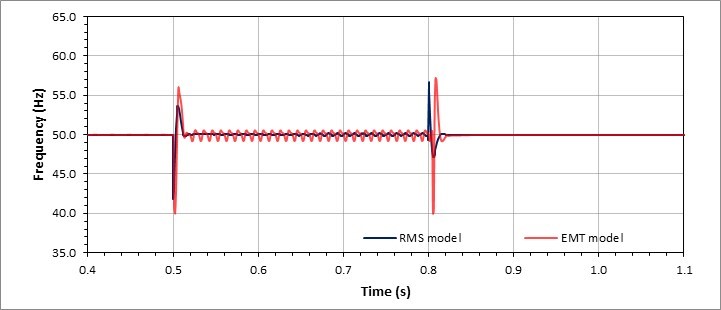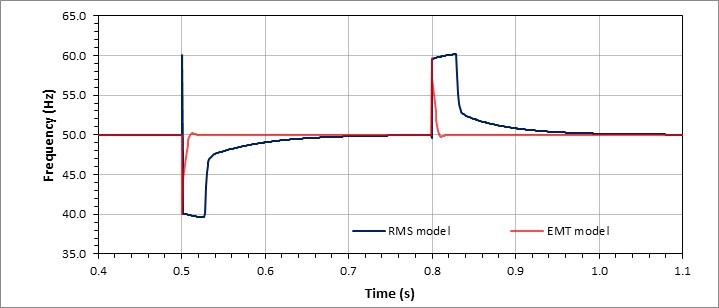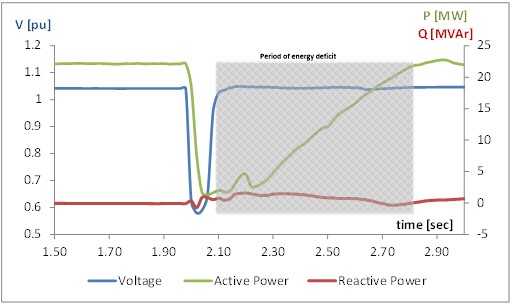
In this series of short technical articles, we look at various topics that illustrate the complexity of renewables as a concept within the ongoing energy transition. This first article by PSC’s Zia Emin considers a range of system performance metrics and what we can expect as the energy transition evolves.
At a minimum, the transition toward a carbon-neutral electrical power network involves increased levels of renewable generation connection, changes in demand profile and content, and increased utilization of DC interconnectors. All these interface with the grid through power electronic devices, i.e., converter technology.
Declining inertia
The fundamental change of the energy transition involves replacing conventional synchronous generators with in the form of renewables (e.g., wind, solar, battery) or interconnectors (e.g., HVDC). A synchronous generator has high levels of inertia due to its stored kinetic energy. It hence can provide a high level of short-circuit current, both of which are important in terms of the system’s operability.
Changing demand curve
Added to this is the change in demand profile and content. The increased use of distributed energy resources (DERs) like electric vehicles (EVs) is a typical example of an increased load profile during peak charging times as well as the chargers utilizing converter/inverter technology.
Challenging voltage control
A very important area of complexity is in the system’s dynamic behavior under increased levels of such change. Generally, inverter-based resources (IBRs) are more flexible in control functionality but are equally complex in their control structure. The control structure generally has fast control loops, i.e., high bandwidth, primarily to have an increased level of control of power output (both active and reactive).
At times, it is possible to witness instability or control interaction issues, especially when the grid strength is minimal. Hence, as synchronous generators are replaced with IBRs, the regulation and control of voltage are becoming increasingly complex and . Furthermore, IBRs employ a phase-locked-loop (PLL) mechanism to follow the grid voltage. Again, such technology is prone to instability when grid strength is relatively low. Studying the behavior of the PLL is in itself a task that is becoming cumbersome in the sense that classical analysis based on root-mean-square (RMS) dynamic simulation is not adequate in identifying all aspects of their behavior.
Figures 1 and 2 show the simulated response of a typical all-pass filter PLL obtained under RMS and electromagnetic (EMT) simulation environments following an unbalanced fault and a phase jump. The comparison clearly demonstrates the lack of an RMS model PLL response and this type of complex control behavior can be demonstrated under other conditions.

Figure 1 Behaviour of an all-pass filter PLL under an unbalanced fault study in RMS and EMT domains [1]

Figure 2 Behaviour of an all-pass filter PLL under an phase jump study in RMS and EMT domains [1]
Increasing rate of change of frequency
Complexities surrounding frequency stability revolve around the lack of inertia and, as a result, an increased rate of change of frequency (RoCoF). Operation of RoCoF protection relays has been identified as the most critical issue in Ireland, for example, following the loss of the largest infeed [2], and the situation has been resolved by revising the settings. Slow response to active power recovery following faults has been another possible area of concern following faults where the controllers are tasked with providing reactive current to support voltage. An actual recording of such a situation has been captured in the Irish system, as is shown in Figure 3. In a situation like this, the priority is on the reactive power, and if the provision of active power is not fast enough, frequency transients, known as voltage-dip induced frequency-dip, may occur.

Figure 3 Illustration of energy deficit due to slow wind generation output recovery following a network disturbance (Source: EirGrid) [3]
There is potential to observe subsynchronous resonance due to the possibility of some types of power electronic controls exhibiting negative damping resulting in amplifying subsynchronous currents and, in effect, introducing sub-synchronous control interactions (SSCI).
Increasing volatility
Then there is the volatility of renewables in terms of their intermittent nature, i.e., demand being met by renewables only in specific periods and not being there at all at other times. It is still a dilemma to untangle this level of volatility even though more storage technology is being developed nowadays.
Final words
Significant changes in the mixture of generation and integration of renewables in the form of converter technology pose many challenges. However, the future is not so bleak in terms of these complexities as technology and our understanding and analysis of practical aspects of issues are growing daily.
This article is the first in a series of short articles covering various angles related to the complexity of renewables. Check out other topics here.
If you’re interested in being notified when new articles in this series are published, please let us know by clicking here.
References
| [1] | B. Badrzadeh, Z. Emin, E. Hillberg, D. Jacobson, L. Kocewiak, G. Lietz, F. F. Da Silva and M. Val Escudero, “The Need for Enhanced Power SYstem Modelling Techniques and Simulation Tools,” CIGRE Science & Engineering, no. 17, pp. 1-17, 2020. |
| [2] | EirGrid, “All Island TSO Facilitation of Renewables Studies,” 2010. |
| [3] | A. Halley, N. Martins, D. Jacobson, W. Sattinger, Y. Fang, L. Haarla, Z. Emin, M. Val Escudero, S. Almeida de Graaf, V. Sewdien and A. Bose, “Effects of Increasing Power Electronics Based Technology on POwer System Stability: Performance and Operations,” CIGRE Science & Engineering, no. 11, pp. 1-13, 2018. |
Series links
The complexity of renewables, Part 1 – PSC Consulting
The complexity of renewables, Part 2 – PSC Consulting
The complexity of renewables, Part 3 – PSC Consulting
The complexity of renewables, Part 4 – PSC Consulting
The complexity of renewables, Part 5 – PSC Consulting
The complexity of renewables, Part 6 – PSC Consulting
The complexity of renewables, Part 7 – PSC Consulting
The complexity of renewables, Part 8 – PSC Consulting
The complexity of renewables, Part 9 – PSC Consulting
